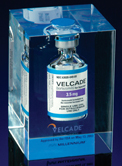DTP Branches and Offices
Success Story

Velcade. Courtesy of DTP.
Velcade (NSC 681239)
Velcade is the first treatment in more than a decade to be approved for patients with multiple myeloma.
“This level of cellular activity is really quite exciting. The drug is the first to be fully developed in this new class of proteasome inhibitors, and its effectiveness as a single agent in that setting gives us hope it may be even more active when used to treat the disease initially.”
1995
Velcade (NSC 681239) is a boronic acid dipeptide discovered by Proscript, Inc. (since acquired by Millennium Pharmaceuticals). It was submitted to DTP for screening along with 18 analogs in 1995. It is a "first in class" inhibitor of the 20S segment of the proteasome, the cellular component that regulates the degradation of many cell cycle control proteins. Velcade was highly potent against all cell lines in the DTP in vitro screen with an average GI50 of 17.8 nM. Potency of growth inhibition in the DTP cell line screen, correlated with 20S proteasome inhibitory potency as determined by the company.
1997
Testing by DTP in the hollow fiber assay resulted in the selection of Velcade along with two analogs for development for clinical trials. Velcade emerged as the best clinical candidate. DTP assisted in the development of Velcade by providing additional in vivo animal studies, formulation, and toxicity studies. Development of a means to measure the drug in plasma was not possible due the very low doses employed and the drug's rapid clearance. However, its effect on the 20S proteasome could be monitored using an ex vivo assay developed by the company. Velcade exhibited a dose-dependent and reversible inhibition of the 20S proteasome inhibition in this ex vivo assay that correlated well with efficacy doses.
Toxicity studies indicated that Velcade had a very narrow therapeutic index (the difference between the effective dose and the toxic dose). Other than death, no clinical signs of toxicity were noted. The narrow safe dose range could have been problematic had there not existed a pharmacodynamic (PD) endpoint. A dose of 0.067 mg/kg was found to decrease 20S proteasome activity by 70% one hour after administration.
1999
Based on these studies, the clinical starting dose was set at 0.13 mg/m2/dose. The ex vivo 20S proteasome assay was used to confirm the inhibition of the target. The PD measurement as an endpoint was used in lieu of blood drug levels, and it guided dose-escalation. Clinical results reported in 2002 for 137 patients showed that the target effective dose (TED) was between 1.6 and 1.9 mg/m2, with proteasome inhibition reaching 72%.
2003
Major responses observed against patients with multiple myeloma led to approval of the New Drug Application in May of 2003.
1 National Cancer Institute. Bortezomib (Velcade) Delays Progression of Advanced Multiple Myeloma Longer than Standard Therapy.
Links:
Velcade poster (pdf)





